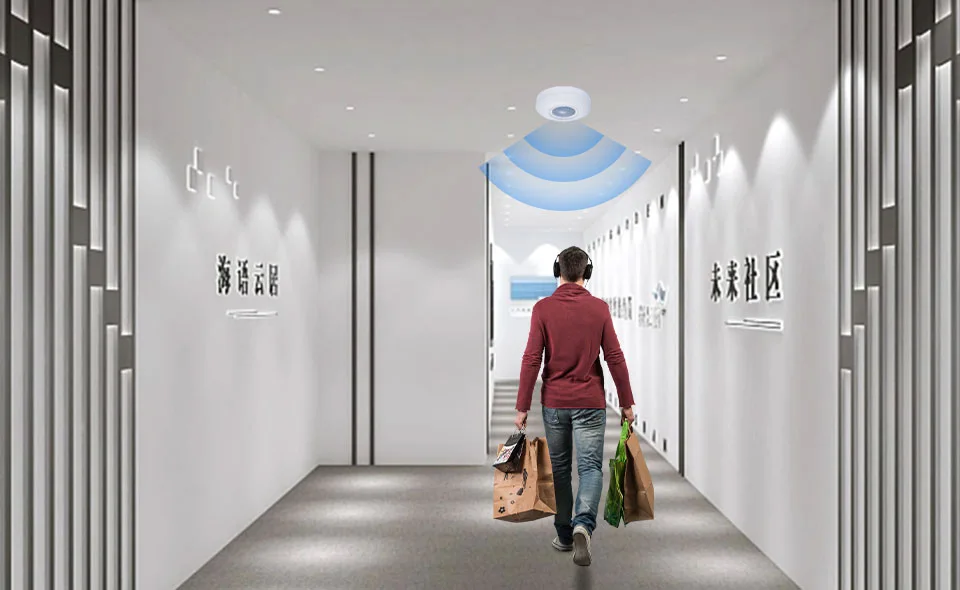The human body infrared intelligent sensing switch is a switch that is automatically activated when someone passes by the infrared sensor detection area. The main device of the human body infrared sensor switch is the human body pyroelectric infrared sensor. The human body has a constant body temperature, generally at 37 degrees, so it emits infrared rays with a specific wavelength of about 10 μm. The passive infrared probe works by detecting the infrared rays emitted by the human body around 10 μm. The 10μm infrared rays emitted by the human body are enhanced by the Fresnel filter and then gathered on the infrared sensing source. The infrared induction source usually uses a pyroelectric element, which will lose its charge balance when it receives a change in the infrared radiation temperature of the human body, and release the charge outward, and the subsequent circuit can trigger the switch action after detection and processing. If the person does not leave the sensing range, the switch will continue to be on; after the person leaves or remains in the sensing area for a long time, the switch will automatically turn off the load with a delay.
Sensing range:
The infrared sensor switch has a sensing angle of about 120 degrees, a distance of 3-10 meters, and an adjustable delay time.
Applications:
The scope of application of automatic human body infrared sensor switch is suitable for automatic lighting and ventilation in corridors, corridors, warehouses, garages, basements, toilets and other places. It truly embodies the modernization of building intelligence and property management.
Features:
- Automatic control products based on infrared technology. When the person does not leave and is active, the switch continues to conduct; after the person leaves, the switch automatically turns off the load after a delay, the light is on when the person arrives, and the light is off when the person leaves, which is friendly and convenient, safe and energy-saving.
- With zero-crossing detection function: non-contact electronic switch, prolonging the service life of the load.
- Photosensitive control is applied, the switch automatically measures light, and it does not sense when the light is strong.
Installation:
- The sensor switch can be divided into 86-type sensor switch and ceiling-mounted sensor switch in terms of appearance.
- The 86-type sensor switch is the same size as the traditional mechanical wall switch, and can directly replace the original wall switch.
- The installation methods of ceiling-mounted sensor switches are similar, taking BR-306C as an example. Make a circular hole with a diameter of 60mm on the ceiling. L, N, LOUT, and NOUT are respectively connected to the incoming line of live wire, incoming line of neutral line, outgoing line of live line and outgoing line of neutral line. After connecting the wires, just buckle the switch into the ceiling; if there is no ceiling in the installation environment, you can first lock the switch top box on the top with screws, and then screw the switch into the bottom box.
- Since the sensing range of the left and right sides of the switch is larger than that of the upper and lower sides, when installing the switch, the positive axis should be as perpendicular as possible to the direction of the person’s walking path, so as to achieve the best sensing effect.
- After installing the switch, turn on the power. When the ambient light is sufficient, the bulb will flash three times. After one minute, the initialization is completed, and the switch enters the monitoring state. Cover the ambient light with an object to make the switch work. People do not leave and are active. The switch will continue to work; after the person leaves, the switch will automatically turn off the load with a delay.
- After installing the switch, turn on the power. When the ambient light is insufficient, the switch will directly enter the monitoring state. If the person does not leave and is active, the switch will continue to work.
- If you are not satisfied with the delay time or light sensitivity value, you can adjust it through the “TIMER” and “DIMMER” on the back of the 86-type wall switch. The former adjusts the delay time and the light sensitivity value. When adjusting, use a screwdriver to twist lightly, and do not use too much force. For the ceiling sensor switch, the adjustment potentiometer can be seen by opening the cover.
